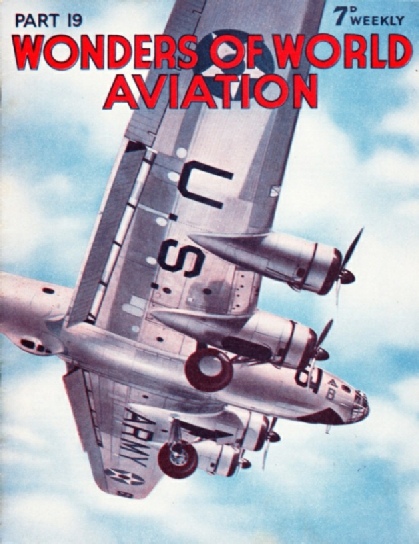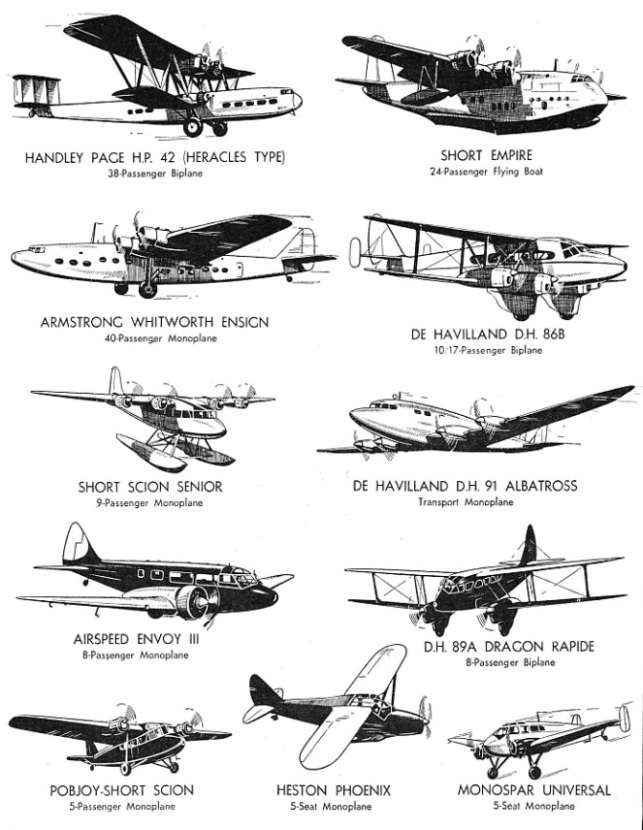
© Wonders of World Aviation 2015-


Part 19
Part 19 of Wonders of World Aviation was published on Tuesday 12th July 1938, price 7d.
This part included a colour plate showing the upper component of the Short Mayo composite aircraft “Mercury”. It formed part of the article on The Certificate of Airworthiness.
This colour plate previously appeared as the cover to part 14.
The Cover
This week’s cover shows one of the United States Boeing YB-17 heavy bombers during a landing approach with flaps down/ This type of aircraft has four 1,000 horse-power Wright Cyclone nine-cylinder radial air-cooled engines.
The cover was later used as the colour plate with part 34.

Contents of Part 19
First Aviator to Fly the Channel (Part 2)
Great Britain’s traditional insularity was weakened if not destroyed in forty minutes on July 25, 1909, when Louis Bleriot became the first man to cross the English Channel in an aeroplane. This chapter by H. G. Castle, shows that, although Bleriot’s fame rests on his cross-Channel flight, his other contributions to aviation were no less important. The article is the ninth in the series on Makers of Air History and is concluded from part 18.
The Certificate of Airworthiness
In the early days of flying anyone who had the inclination (and the money) could not only build an aeroplane, but he could also fly it and carry passengers in it without there being any official supervision. There were no standards for designers and constructors to follow. If there was an accident, there was no inquiry into it, except an inquest, should it have been a fatal accident. Now, before any machine is allowed to fly in Great Britain, the Air Ministry must be satisfied that it conforms to certain standards; and when an aeroplane does conform to these standards a Certificate of Airworthiness is granted. This is no mere formality, but is granted only after a series of the most exacting tests. In 1920, when civil aviation was developing rapidly, the Air Navigation Act was passed. This Act carried with it widespread powers. Among other things it provided for the licensing, inspecting and regulating of aerodromes; it gave inspectors free access to aerodromes and to factories to see the work in progress. The Act has set a standard of safety. It has destroyed the casual, haphazard methods of designing, and has given aircraft designers a leaf in the right type of development.
Refuelling During Flight
The idea of refuelling a machine in the air is not new. Refuelling was tried experimentally in Great Britain during the later stages of the war of 1914-18; but no progress was made for some years, chiefly because the attendant disadvantages outweighed the possible advantages to the aircraft of the period. Now, however, with modern aeroplanes and apparatus, the possibilities of refuelling during flight are becoming increasingly more interesting. This chapter describes a system whereby aeroplanes have remained in the air for weeks without landing.
Traffic Rules of the Airways
It might be assumed that with so large an expanse as the sky m which to manoeuvre it would not be necessary for pilots to have specific traffic regulations. But the aviator’s margin of safety is confined to the distance at which he can see an approaching machine. In clear weather it is seldom possible to see an approaching aeroplane more than a few miles ahead. Poor visibility will restrict this range of vision. Cruising speeds of 200 miles an hour are common today, and two aeroplanes flying towards each other on the same course would approach so quickly that little time would elapse before the machines were level. As it is, regulations exist to reduce to a minimum the possibilities of a collision occurring in normal conditions. Air traffic rules were first laid down by international agreement in the Convention for the Regulation of Air Navigation signed in Paris in 1919. Most countries of the world were signatories to the agreement, and thus most pilots obey the same traffic rules; these rules are largely based on the Regulations for the Prevention of Collision at Sea. Air traffic rules and regulations are numerous and, to the uninitiated, complicated, but a comprehensive knowledge of these rules and of the signals which aircraft must carry is an essential requirement of every pilot engaged in international aviation.
William Leefe Robinson, VC
A biography of William Leefe Robinson VC, who was the first pilot to bring down an enemy airship in Great Britain.
This chapter is the second article in the series on Epics of Service Flying.
Novel Uses of the Aeroplane (Part 1)
Many and varied are the fields of enterprise into which the aeroplane had found its way in recent years. Its advent has revolutionized old-established industries. All over the world aircraft have been used for purposes scarcely contemplated by the pioneers of flight. This chapter describes how governments and private enterprises cooperate with aircraft. The article is concluded in part 20.
